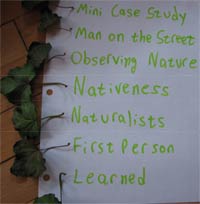| Class Site | Jay Silver |
A Case Study of Becoming an Explorer - Dec. 2007


 Comments
Comments
Spontanious Observing
|
Really Looking at Trees
I'm watching for a couple of things when I ask these explorers "what natural processes do you see right here right now?" I'm watching to see how they react spontaneously, but I'm also curious to see what clues they reveal about how they normally think about their landscape on a daily basis. |
|
|
|
What is Nature?
If we're watching natural processes, what parts of the world does nature include? Are human-made devices and structures part of nature? What about human tracks and wastes... and humans themselves? I tend to think of Nature less as "trees" (so to speak) and more as the truthful properties of the way things are -- the fact sheet of the Universe including complex interacting processes. |
|
Shutsu and the Unexpected Processes She Notices
From the way Shutsu describes her knowledge of the "sun bleached" columns, it almost sounds like she had chosen this place to study. But she hadn't. This was just where we happened to be for the interview, as well as being near enough to campus that she has probably been there many times. But what's fascinating is the way she talks about the columns... as if she has looked at them and wondered about the discoloration several times before... actively engaged... she says "I noticed it one night when I was walking by..." |
|
|
|
Water Reveals
As David Lee says, snow and rain can be very revealing: "I think I pay more attention to water drainage these days. More than the actual falling of snow and rain." What if you could just dump water over any landscape to learn where all the low spots were? That would be hard to do, so we can just wait for a rain. To study wind patterns it might help to release a big box of "styrofoam peanuts", or just wait for fall and watch the leaves. |
|
Practical Urban Exploration
Deciding where to live based on the sun. This is an interesting example of measuring of the invisible, temperature, using visual indicators. |
|